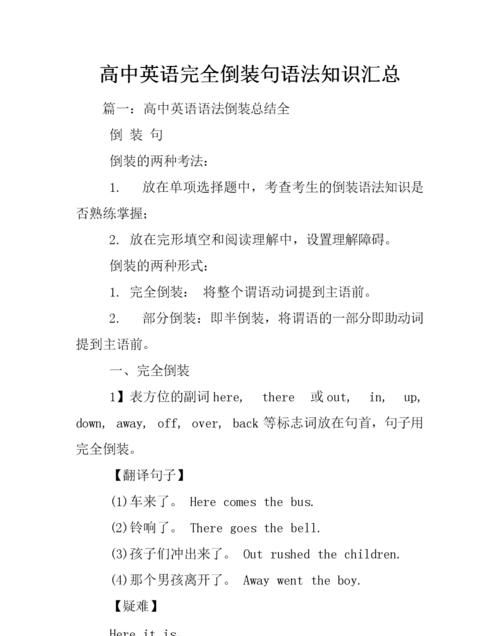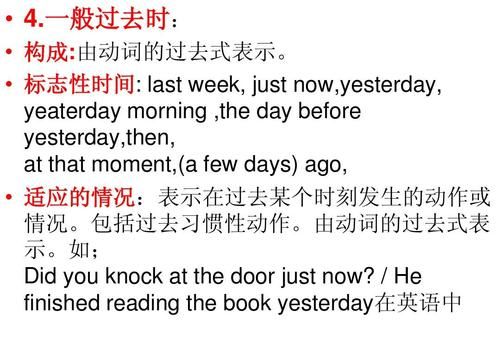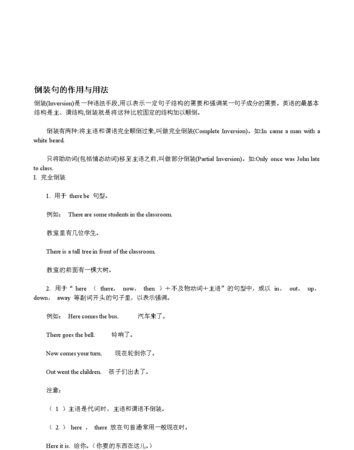本文目录
英语完全倒装和部分倒装
1.全部倒装(Full Inversion), 又称主谓倒装
(Subject-verb Inversion).
例如: Here are some letters for you.
Down poured the rain.
Into the coach scrambled the children.
全部倒装句的具体用法
1.用于由here, there, now, then 等副词引导的句子,通常称作把时间状语或地点状语提前的倒装句,其谓语动词通常跟在时间状语或地点状语之后.
例如: Then came a new development that had a far-reaching effects.
Once upon a time, there lived a man known by the name of Joe Beef.
Now comes your turn.
2.在带有助动词“ be ”的句子中,动词-ing和-ed形式可移至句首,主语移至“ be ”后面,形成全部倒装.
例如:Running across it is a stream.
Buried in the sands was an ancient village.
Pictured here is a wooden tub used for gathering water chestnuts
3.为了使描写的景象更生动,常把拟声词或away, in, out, up 等状语放在句首,从而引起主谓全部倒装.
例如:Down it fell from the apple tree.
The door opened. In rushed the crowd.
4.当句子的主语较长而谓语较短时,常将状语放在句首,主谓全部倒装使句子结构平衡,避免头重脚轻.
例如:Faint grow the sound of the bell.
At the end of the kaleidoscope are two plates, one made of the glass and the other of ground glass
5.用于表示祝愿的句型.
例如:May you live a long and happy life !
Long live the People’s Republic of China !

英语都是倒装句为什么那么多
因为倒装句需要把助动词提前,而现在进行时的助动词是be.
如果想把
He
is
playing
tennis
in
the
playground.改成倒装句
Is
he
playing
tennis.......这就变成疑问句了,行不通的。
而且倒装句有固定的那么几种,记住就好了,不要执着于那些比较细节的部分。

完全倒装为什么不能用进行时态
完全倒装
1) 完全倒装即把整个谓语放到主语之前(是整个谓语动词,而非助动词)。
例如:In came the teacher and
the class began. (老师走了进来,然后开始上课。)
2) there引出的完全倒装句:除了最常见的there
be句型以外,there还可以接appear, exist, lie, remain, seem to be,
stand等,一般都译成"有"的含义,构成完全倒装句。
例如:There appeared to be a man in black in the
distance.(远处有个穿黑色衣服的人。)
3) 由地点和时间副词引出的完全倒装句:以地点副词here, there和时间副词now, then
开头,后面的动词是be, come, exist, fall, follow, go, lie, remain, seem,
stand等,而主语又是名词时,构成完全倒装句。
例:Under that tree sits a beautiful
girl.(那棵树下坐着一位美丽的姑娘。)
例:_________ from the tenth floor when the policeman
pointed his pistol at him.
A) Jumped down the burglar B) Down the
burglar jumped
C) The burglar jumps down D) Down jumped the
burglar
答案是D) Down jumped the
burglar。因为地点状语Down位于句首应该用完全倒装,整个谓语动词应位于主语之前。C) The burglar jumps
down虽然是自然语序,但时态错误,应该用和时间状语从句一致的过去时,而不是现在时。
注意:
1) 在here,
there引出的倒装句中,当主语是普通名词时用完全倒装句,但当主语是代词时,就要用部分倒装句。
例:Here comes the
postman!(邮递员终于来了!注意实意谓语动词位于主语之前。)
Here we are.(我们到了。注意系动词位于主语代词之后。)
2)
注意正语序和倒装语序的语气、意义是区别:
例:Here is the picture I love.(这正是我所喜爱的画。)
The
picture I love is here.(我所喜爱的话在这里。)
3)
当主语是代词,谓语是系动词,表语是说明性的词、词组和定语从句时,可以使用完全倒装句,起强调作用。
例:Lucky is he who has been
enrolled into a famous university.(他真幸运,被一所名牌大学录取了。)

英语完全倒装和部分倒装
1.全部倒装(Full Inversion), 又称主谓倒装
(Subject-verb Inversion)。
例如: Here are some letters for you.
Down poured the rain.
Into the coach scrambled the children.
全部倒装句的具体用法
1.用于由here, there, now, then 等副词引导的句子,通常称作把时间状语或地点状语提前的倒装句,其谓语动词通常跟在时间状语或地点状语之后。
例如: Then came a new development that had a far-reaching effects.
Once upon a time, there lived a man known by the name of Joe Beef.
Now comes your turn.
2.在带有助动词“ be ”的句子中,动词-ing和-ed形式可移至句首,主语移至“ be ”后面,形成全部倒装。
例如:Running across it is a stream.
Buried in the sands was an ancient village.
Pictured here is a wooden tub used for gathering water chestnuts
3.为了使描写的景象更生动,常把拟声词或away, in, out, up 等状语放在句首,从而引起主谓全部倒装。
例如:Down it fell from the apple tree.
The door opened. In rushed the crowd.
4.当句子的主语较长而谓语较短时,常将状语放在句首,主谓全部倒装使句子结构平衡,避免头重脚轻。
例如:Faint grow the sound of the bell.
At the end of the kaleidoscope are two plates, one made of the glass and the other of ground glass
5.用于表示祝愿的句型。
例如:May you live a long and happy life !
Long live the People’s Republic of China !

以上就是关于进行时态不能用于全部倒装 ,英语完全倒装和部分倒装的全部内容,以及进行时态不能用于全部倒装 的相关内容,希望能够帮到您。
